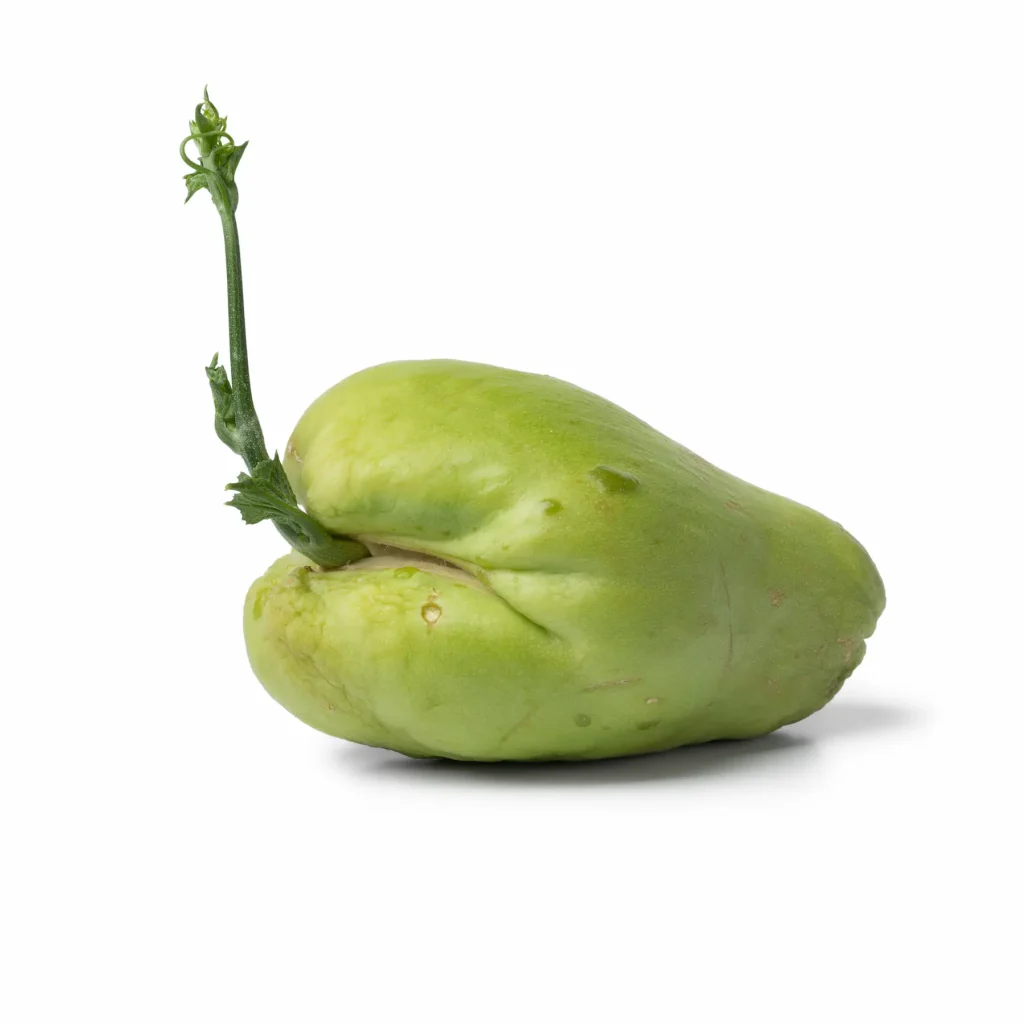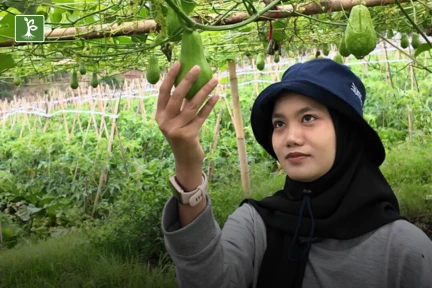Chayote (Sechium edule L.) is a vegetable native to the America that grows in areas with an altitude of 200-1100 meters above sea level. This vegetable can be cultivated both in lowland and highland areas. The ideal environment for chayote includes temperatures of 18-24°C, humidity of 60-90%, rainfall of 500-2500 mm/month, and soil pH of 5-6.5.
Chayote can be harvested 3-4 months after planting. The productivity of chayote can reach 8-10 tons per hectare in a single planting. Let’s read on to find out how you can plant chayote for an optimal harvest!
1. Chayote Seedling Preparation

To plant chayote, we need to prepare seeds in the form of mature chayote fruit left to ripen on the tree. Large, slightly soft chayote fruits are wrapped in plastic, with a few small holes made or covered to allow root growth.
Alternatively, we can also use chayote bought from the market. First, prepare a glass of water and place the chayote on top of the glass, ensuring it does not submerge. This technique, called propagation, aims to stimulate the growth of shoots or roots from the submerged part of the plant.
2. Chayote Planting

The planting hole for chayote should be 40 cm x 40 cm, with a depth of 20 cm. Add 5 kg of organic fertilizer to the hole and let it rest for a week. The distance between holes should be 3 meters, and between rows, it should be 5 meters.
With this planting distance, the plant density of chayote will range from 1200 to 1500 plants per hectare. Once the shoots grow to around 30 cm, the chayote seedlings should be transferred to the field. Place them in the prepared planting hole and cover them with soil.
3. Installing Trellises

Chayote is a climbing vegetable plant, with fruits hanging above. It’s essential to set up trellises for chayote so that the plant can form tendrils, resulting in larger, optimal fruits that won’t rot easily.
Once the chayote plant starts to grow tall or elongate, trellises can be installed, followed by the addition of ladders and finally, horizontal supports. The trellis should be made of wood or bamboo, approximately 1.5 meters in length, arranged at the top to connect with other bamboo poles. These should then be positioned both horizontally and vertically to form a 30 x 30 cm or 50 x 50 cm grid.
Secure the bamboo connections with raffia ties or nails to ensure the trellis is sturdy enough to support the chayote fruits. Install the trellis when the chayote plant reaches its second week after planting.
The plant’s climbing process must also be assisted by farmers, who should gently attach the tendrils to the trellis. This helps prevent the plant from sprawling in random directions.
4. Regular Watering
Watering should be done periodically. In the first month, water the chayote once a week or adjust based on the weather conditions at the planting site.
However, once the plant enters the generative phase (fruiting phase), increase the watering frequency to every 4 days. When watering chayote, be mindful of the frequency—avoid over-watering, as this can cause the plant to rot and become susceptible to diseases.
Water the chayote directly at the roots to allow for efficient absorption. Avoid watering the leaves, as the water will just fall off or evaporate, increasing the risk of leaf diseases.
5. Supplemental Fertilization
Supplemental fertilization is crucial to stimulate the growth of chayote and enrich the soil with nutrients. Fertilization can target both the roots and leaves.
For root fertilization, you can use two techniques: bury the fertilizer directly into the soil or use fertigation, where the fertilizer is dissolved in water and applied around the roots. Apply organic fertilizer (manure) at a rate of 25 kg per 4 planting holes around the chayote stem.
The day before applying manure, mix in 1-2 kg of NPK fertilizer in 200 liters of water. This amount is for one planting hole, and fertilization should be done every 10-14 days after transplanting the seedlings.
For leaf fertilization, use liquid organic fertilizer and spray it directly onto the leaves, following the dosage instructions on the packaging. Leaf fertilization can be done every 7-10 days, but reduce it during the rainy season.
6. Weeding
Weeding should be done periodically to keep the area around the plants clean. Weeds should be removed as they can interfere with the growth of the plants.
Additionally, weeding is necessary because the weeds around the chayote plants will compete for nutrients in the soil. Weeding can be done regularly while monitoring the chayote plants.
7. Pruning
Chayote plants need to be pruned regularly to maintain their health and ensure abundant fruit production.
Pruning should be done on the branches of the chayote plant when it is 3-6 weeks old, allowing the shoots to spread and grow evenly. Old branches that are not growing should be trimmed to encourage new shoots. In addition, old leaves should be pruned to prevent nutrient wastage.
8. Pest and Disease Control
Monitoring of chayote plants is necessary so that pest and disease control can be carried out quickly and effectively. Common pests that often attack chayote include the armyworm (Spodoptera litura), leaf beetle (Aulacophora similis), aphids (Aphis gossypii), leaf miners (Liriomyza huidobrensis), fruit flies (Bactrocera cucurbitaceae), and mites (Tetranychus sp.).
Common diseases affecting chayote include powdery mildew (Podosphaera xanthii, Erysiphe cichoracearum), leaf blight (Pseudoperonospora cubensis), anthracnose (Colletotrichum lagenarium), bacterial wilt (Ralstonia solanacearum), and mosaic virus (Cucumber mosaic virus, Squash mosaic virus).
9. Harvesting Chayote

Chayote can be harvested after 3-5 months of planting. The signs that chayote is ready for harvest include large, mature fruits, a bright green color, and smooth fruit surfaces.
Harvesting can be done when the chayote fruits are still small (baby chayote), about 5-8 cm in length, or when they have reached full size. The fruits should be picked directly by cutting the stem attached to the hanging fruit. Harvesting can be done weekly, with the productive lifespan of chayote reaching up to 3 years.
10. Post-Harvest Handling
After harvesting, the chayote fruits are collected in baskets. Clean the chayote from any dirt or debris using a cloth. Avoid exposing harvested chayote to direct sunlight as it will spoil the taste of the fruit.
Next, separate the chayote fruits into those that are suitable for sale and those that are not (sorting). Pack the chayote in airtight packaging.




